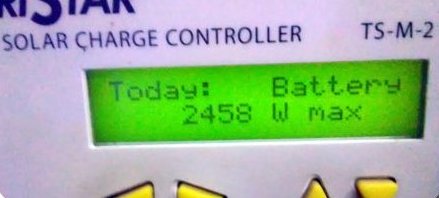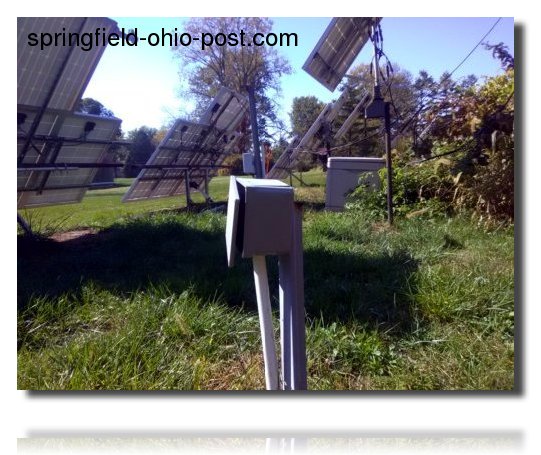Phone Texting: (727) 834-0438
2803 Troy Road
Springfield Ohio 45504
2803 Troy Road, Springfield Ohio

Anyone in solar that doesn't have a true MPPT Charge Controller has heard about MPPT without having to do any special research to find the mention of MPPT.
Most will be shocked at the price difference between the units.
And most again, wants an MPPT in the hopes that the reviews are true concerning the advantages of MPPT over PWM Charge Controllers.
For the past few months a PWM set at 48v to match the solar array and battery bank was monitored with poor results. The poor results are despite the fact that the load is miniscule compared to the ah (amp-hour) capacity of the bank's energy. Dealing with numbers, I tend to round-off and will do so while explaining the scenario.

The 48v battery bank is comprised of 16qty 6v batteries which results in a parallel of two 48v batteries. The total rated ah capacity is 450ah. It doesn't seem practical to assume that all those amp hours are able to be utilized, so I generally cut that number in half for good measure. Our 2019 society has become accustomed to products being overrated, so-much-so that the public (consumer) appears to have sprouted a blind-eye toward the issue entirely.
Just to be safe I cut the number in half and it seems I could possibly lower the true capacity of a battery slightly more. But these are the batteries we have to work with so I digress.

The entire load on the bank is comprised of one small top-load freezer and a security system (during the night). During the day there are the washer, dryer, and a few more items that are plugged in from time-to-time.
The results may not increase in favorability when the season changes to summer, this is due to the fact that 24 out of the 28 100w solar panels already face the optimal direction of the seasonal winter sun.
What has been observed is that the battery bank is not performing as is should.
The battery bank rarely reached the charge controller's happy-blinking-light (the indicator that informs the owner that it has gone into float stage after having fully completed the bulk stage). However an MPPT charge controller has abilities not found in that of the PWM controllers.

Before I continue stating more about the tests that were done here, it should be clarified to any that are not cognitive of the advantages in MPPT.
An MPPT can convert a 48v solar array to charge a 12v battery. It can also take a 48v solar array to charge a 12v battery. It can also take a 24v solar array to charge a 12v battery. It can also take a 24v solar array to charge a 24v battery bank. It can also take a 24v solar array to charge a 48v battery bank. It can take a 12v solar array to charge a 24v battery bank. (I would continue but I hit a rough spot in keeping track).
A PWM Charge Controller cannot do any of the above-mentioned capacities.
Additionally, PWM tend to only possess limited levels of charging, whereas an MPPT contains added levels to the PWM's "Bulk", "absorption" and "Float" rates.
For the testing I used two controllers by the same well-reputed manufacturer, Morninstar.
Both controllers are rated at a maximum input of 150volts 60amps.
The somewhat confusing part is when one finds that amps x volts = watts
Are you ready for the confusion?
An average 100w solar panel is rated to produce 5 or 6 amps (industry average). This math doesn't work out (and now we're back to the capitalism-factor).
12v x 5a = 60w; 12v x 6a = 72w
And as if that weren't enough, the other variables such as how much sun and the amount of clouds or pollution in the air, wire-sizing drops in power per foot of wire!

More variables are temperature of the solar arrays and temperature of the battery banks and temperature of the wire and whether or not the bank ever reaches a point of completion in the absorption state (thereby never reaching the float stage which is the goal of a properly charged battery via PWM Charge controllers). Other variables such as wire quality, solder quality, one solitary loose wire even!
In a few days the PWM controller will be removed from the 48v battery bank and the MPPT controller put in its place.
So having weighed all the myriad of variables, it's been determined that the load of appliances are miniscule and a moot variable in the problem. This was further determined by removing all loads for a week to witness whether the battery bank improved (reaching the float stage).
It has already been determined that the amount of panels in the solar array ought to be over-kill to charge a 48v battery bank without a load, yet the bank just seemed to be in a lull.

Directly beside the 48v battery bank is a 12v battery bank. The 12v battery bank has a 48v solar array so must be utilizing the MPPT Controller to accomplish this. The 12v battery bank only has a rated capacity of 370ah but only is utilized in powering some l.e.d. lights and a few cameras.
This smaller 12v battery bank always out-performs the 48v battery bank, despite the fact that there are only 8 (possibly 12, my memory escapes me at this moment) 100w 12v solar panels being utilized.

The contrast of solar energy to amp-hour capacity is pronounced with the 12v battery bank reaching full capacity even during days with little sun.
Since this is an on-going test, the results (with an expected outcome) will be forthcoming. Whereas the 12v battery bank, which also was earlier tested with the PWM Controller, equally did not fare as well as it does now with the MPPT Controller. So the 12v battery bank will continue with the MPPT controller.

There is an identical MPPT controller, equally-rated at 150v 60a which presently is not being utilized, this controller will be installed to the 48v battery bank. Following the completion of the test (approximately one month from the time of installation), the results will be placed within the context of this web page.
Just for the record, this test started with an MPPT charge controller already adapted to the 48v battery bank initially. It was presumed that a PWM Controller would work just as fine since the PWM is dealing with like-voltages (48v solar array to a 48v battery bank). This does not appear to be a case where there is much advantage in having a PWM Charge Controller.
Today's Date is Thursday, 01-Jan-2026 05:08:03 EST
2014-2025 Kenny Hendrick and the Public Diary. All Rights Reserved.
Posted for educative purposes under THE FAIR USE NOTICE: Some content contained within this website may contain copyrighted (© ) material, the use of which has not always been specifically authorized by the copyright owner. Such material is made available to advance understanding of ecological, economic, scientific, political, human rights, democracy, moral, ethical, and social justice issues, etc. It is understood that this constitutes a 'fair use' of any such copyrighted material as provided for in section 107 of the US Copyright Law. In accordance with Title 17 U.S.C. Section 107, some material contained within this website and it's content is distributed without profit to those who have expressed a prior general interest in receiving similar information for research and educational purposes. For more information see: http://www.law.cornell.edu/uscode
"Copyright Disclaimer Under Section 107 of the Copyright Act 1976, allowance is made for "fair use" for purposes such as teaching, news reporting, criticism, comment, scholarship, and research. Fair use is a use permitted by copyright statute that might otherwise be infringing. Non-profit, educational or personal use tips the balance in favor of fair use." Disclaimer: 17 Notwithstanding the Provisions of Sections 17 U.S.C. @ 106 and 17 U.S.C. @ 106A, the Fair Use of a Copyrighted work for Educational Purposes- Not For Profit- Non-Commercial. (https://creativecommons.org/licenses/by-sa/3.0/legalcode